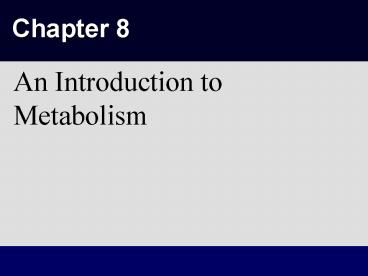An Introduction to Metabolism - PowerPoint PPT Presentation
1 / 34
Title:
An Introduction to Metabolism
Description:
On the platform, a diver. has more potential energy. Diving converts potential ... In the water, a diver has. less potential energy. Thermodynamics ... – PowerPoint PPT presentation
Number of Views:16
Avg rating:3.0/5.0
Title: An Introduction to Metabolism
1
Chapter 8
- An Introduction to Metabolism
2
Metabolism
- The total of an organisms chemical reactions.
- Types
- Catabolic (break down)
- Anabolic (building)
3
Bioenergetics
- The study of how organisms manage their energy.
- Energy- the capacity to cause change
- Kinetic- energy of motion
- Potential- energy that matter possesses
- Chemical- potential energy available for release
in a chemical reaction
4
Transformations between kinetic and potential
energy
5
Thermodynamics
- The study of energy transformations that occur in
a collection of matter.
6
Figure 8.3 The two laws of thermodynamics
7
The relationship of free energy to stability,
work capacity, and spontaneous change
.
8
Free energy changes (?G) in exergonic and
endergonic reactions
9
Complementary Reactions
- Photosynthesis- Endergonic
- Cell Respiration- Exergonic
10
Redox Reactions
- Oxidation Reduction
11
Oxidation
- Loses electron
- Loses Hydrogen atom
- Adding oxygen
- Cell Respiration
- CH2O O2 ? CO2 H2O Energy
12
Reduction
- Gains electron
- Gains hydrogen atom
- Photosynthesis
- CO2 H2O ? CH2O O2
13
Redox and Energy
- An electron loses potential energy when it moves
from a less electronegative atom to a more
electronegative one (like oxygen) - This energy can be used for work.
14
The structure of adenosine triphosphate (ATP)
15
The hydrolysis of ATP
16
Figure 8.11 How ATP drives cellular work
17
The ATP cycle
18
Enzymes
- Protein catalysts
- Reusable
- Lower Activation Energy (energy needed to start a
reaction) - The reaction catalysed by orotidine 5'-phosphate
decarboxylase will consume half of its substrate
in 78 million years if no enzyme is present.
With enzyme- just 25 milliseconds.
19
Example of an enzyme-catalyzed reaction
hydrolysis of sucrose by sucrase
CH2OH
CH2OH
CH2OH
CH2OH
O
O
O
O
H
H
H
H
H
H
H
Sucrase
H
HO
OH
H
H
OH
H2O
HO
O
H
H
OH
O
HO
CH2OH
CH2OH
HO
OH
H
H
H
H
OH
OH
OH
Fructose
Glucose
Sucrose
C12H22O11
C6H12O6
C6H12O6
20
Energy profile of an exergonic reaction
21
The effect of enzymes on reaction rate.
22
Note
- Amount of energy released is NOT affected. The
amount of energy needed IS (activation energy)
23
Induced Fit Hypothesis
- Enzymes are specific.
- Enzyme slightly changes shape (at the active
site) when substrates bind. - Enhances fit, and therefore, the catalytic
ability. - In contrast to Lock and Key model
24
Induced fit between an enzyme and its substrate
25
The active site and catalytic cycle of an enzyme
26
Factors affecting Enzymes
- Temperature
- High- denatures enzymes
- Low- molecules move slow
- pH- denatures enzymes
- Amount of substrate
- Presence of inhibitors
27
Environmental factors affecting enzyme activity
28
Cofactors/Coenzymes
- Enzyme helpers (some enzymes dont work unless
cofactor is bound to it) - Coenzymes- organic cofactors i.e. vitamins
29
Competitive Inhibition
- Something else binds to the active site
30
Noncompetitive Inhibition
- Something else binds to enzyme, causing it to
change shape, and altering the active site. - Allosteric Enzyme- changes shape
31
Inhibition of enzyme activity
Competitive inhibitor
A noncompetitive inhibitor binds to the enzyme
away from the active site, altering the
conformation of the enzyme so that its active
site no longer functions.
32
Allosteric regulation of enzyme activity
33
(No Transcript)
34
Feedback inhibition in isoleucine synthesis































